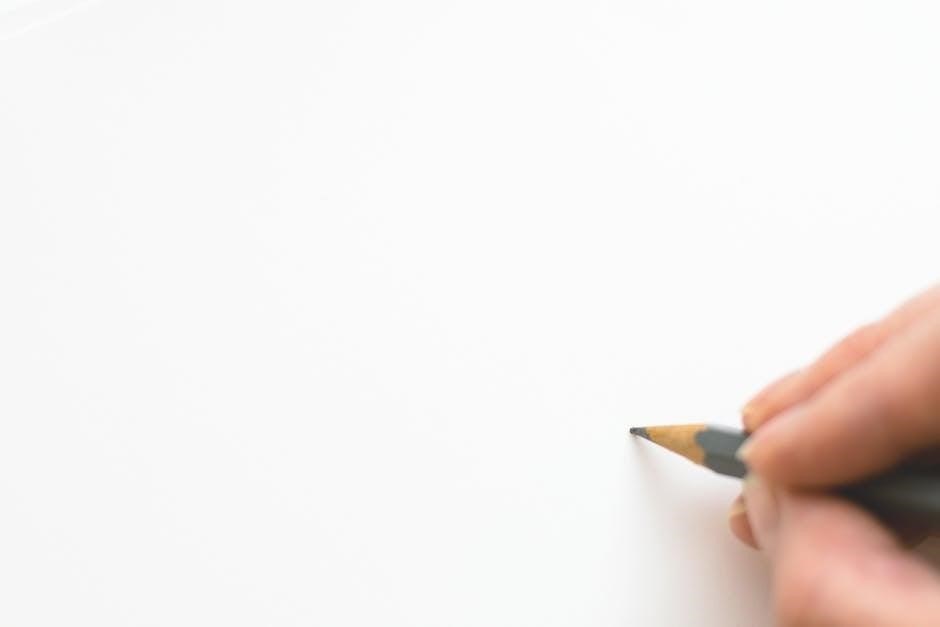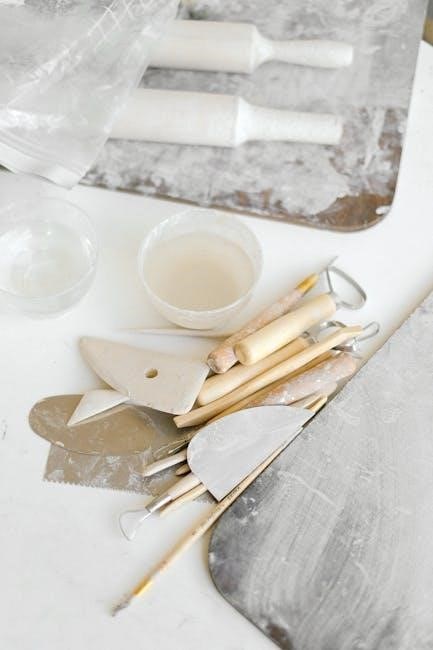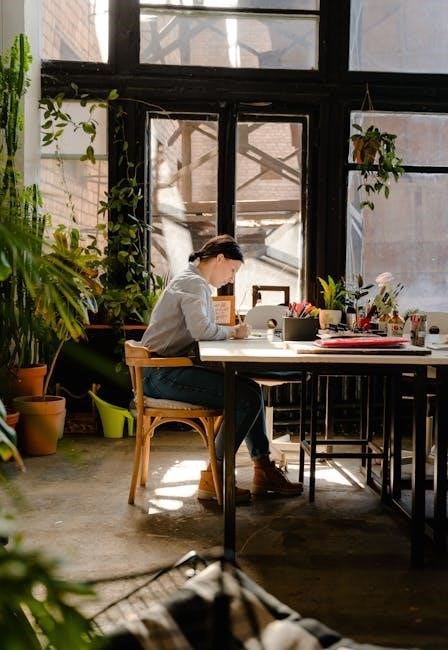manual awnings
Manual awnings are versatile shade structures offering energy efficiency, UV protection, and aesthetic enhancement. Available in various materials and styles, they provide functional and decorative solutions for outdoor spaces.
1.1 Definition and Purpose of Manual Awnings
Manual awnings are fabric or metal coverings attached to buildings, designed to provide shade and protection from sun, rain, and wind. They are typically installed above windows, doors, or outdoor spaces. Their primary purpose is to create a comfortable environment by blocking direct sunlight, reducing heat gain, and preventing UV damage. Manual awnings are operated by hand, offering a cost-effective and energy-efficient solution for outdoor areas. They also enhance curb appeal and add functionality to patios, decks, and storefronts while providing customizable shade options for various settings.
1.2 Brief History of Awnings and Their Evolution
Awnings have ancient origins, with evidence of their use in Egypt and Rome for shade and weather protection; Initially made of cloth or leather stretched over wooden frames, they were later adopted in medieval Europe for market stalls. The 19th and 20th centuries saw the introduction of manual mechanisms, making awnings more accessible for homeowners. Modern materials like aluminum and durable fabrics have further enhanced their functionality, ensuring manual awnings remain a practical and stylish solution for outdoor spaces, blending tradition with innovation.

Types and Styles of Manual Awnings
Manual awnings offer flexibility and durability, available in retractable or fixed designs. They come in various styles, including classic, modern, and decorative options, catering to diverse preferences and needs.
2.1 Retractable vs. Fixed Manual Awnings
Retractable manual awnings offer flexibility, allowing users to extend or retract them as needed, providing shade and sunlight control. Fixed awnings, on the other hand, are permanently installed, offering consistent protection from the elements. Retractable models are ideal for seasonal use or variable weather conditions, while fixed awnings provide a permanent shade solution, enhancing outdoor spaces with a sturdy structure. Both options cater to different needs, ensuring functionality and style.
2.2 Popular Materials Used for Manual Awnings
Manual awnings are crafted from a variety of materials, each offering unique benefits. Canvas and fabric awnings are popular for their lightweight design and breathability, while vinyl and polyester options provide durability and water resistance. Metal frames, often made from aluminum or steel, ensure structural integrity and longevity. Wood awnings add a natural, rustic charm, and recycled materials are increasingly favored for their eco-friendly appeal. The choice of material depends on climate, budget, and desired aesthetic, ensuring functionality and style.
2.3 Common Designs and Styles Available
Manual awnings come in a variety of designs to suit different architectural styles and preferences. Traditional options include flat, dome, and waterfall styles, while modern designs feature sleek, minimalist profiles. Some awnings boast decorative elements like scalloped edges or ornate frames, adding visual appeal. Others offer practicality with adjustable pitch angles for optimal sun control. Customizable colors, patterns, and shapes ensure they blend seamlessly with any setting, whether residential, commercial, or recreational. This versatility makes manual awnings a practical and stylish choice for diverse applications.

Benefits of Manual Awnings
Manual awnings enhance outdoor spaces by providing shade, reducing heat gain, and adding style. They are cost-effective, durable, and customizable, making them a practical choice for homeowners.
3.1 Energy Efficiency and Cost Savings
Manual awnings significantly reduce energy consumption by blocking direct sunlight, lowering cooling costs during summer. Their durable materials ensure long-term savings, while customizable designs enhance energy efficiency without compromising style.
3.2 UV Protection and Sunlight Control
Manual awnings provide excellent UV protection by blocking harmful rays, reducing glare, and preventing furniture fading. They allow natural light while maintaining a cool, shaded environment, enhancing comfort and protecting interiors from sun damage.
3.3 Aesthetic Appeal and Customization Options
Manual awnings enhance outdoor spaces with timeless style and versatility. Available in various colors, patterns, and materials, they offer customization to match any architectural design. Fabric options range from classic canvas to modern synthetics, while frames can be tailored to suit individual preferences. This adaptability allows homeowners to create a cohesive look that boosts curb appeal and reflects personal taste, making manual awnings a practical and stylish addition to any property.

Maintenance and Care for Manual Awnings
Regular cleaning, inspection, and seasonal storage ensure longevity. Remove dirt, check for damage, and store awnings during harsh weather to maintain their functionality and appearance effectively.
4.1 Cleaning and Upkeep Tips
Regular cleaning is essential for maintaining manual awnings. Use mild soap and water to wipe down fabric and frames. Avoid harsh chemicals that may damage materials. For tougher stains, a soft brush can gently scrub away dirt. Ensure the awning is completely dry before retracting to prevent mold and mildew. Inspect hardware for rust or wear and lubricate hinges periodically to ensure smooth operation. Consistent upkeep extends the lifespan and performance of your awning, keeping it functional and visually appealing year-round.
4.2 Repair and Replacement of Damaged Parts
Damaged parts on manual awnings should be addressed promptly to maintain functionality. Check for frayed fabric, bent frames, or worn-out fasteners. Replace torn or faded fabric with durable, weather-resistant materials. For metal components, sand and repaint to prevent rust. If a part is beyond repair, consider purchasing replacements from the manufacturer or a hardware store. Regular inspections help identify issues early, ensuring minor repairs don’t escalate into major overhauls. Timely replacements prevent further damage and extend the awning’s lifespan, ensuring optimal performance and appearance.
4.3 Seasonal Storage and Protection
Proper storage of manual awnings during off-seasons is crucial for longevity. Clean the fabric thoroughly, allow it to dry completely to prevent mold. Disassemble removable parts and store in a dry, cool place. Use breathable materials like canvas bags for storage to avoid moisture buildup. Ensure all metal components are protected from rust with a coat of paint or sealant. Inspect the awning for any damage before storing and address it promptly. This practice ensures your awning remains in great condition for future use.

Installation of Manual Awnings
Manual awnings require secure anchoring to sturdy structures. Ensure proper leveling and alignment for functionality. Follow manufacturer instructions for hardware installation to guarantee safety and stability.
5.1 DIY Installation Guide
Installing manual awnings yourself can save costs but requires careful planning. Start by gathering tools like drills, screws, and measuring tape. Ensure the wall surface is sturdy and level. Mark the awning’s mounting points accurately and drill pilot holes to avoid damage. Assemble the awning frame according to the manufacturer’s instructions. Attach the brackets securely, ensuring they are tightly fastened. Finally, test the awning’s operation by opening and closing it to confirm smooth functionality. Always follow safety guidelines to avoid accidents during installation.
5.2 Professional Installation Recommendations
For a seamless and durable setup, consider hiring professionals to install your manual awnings. Experts ensure precise measurements and proper anchoring, minimizing risks of damage or instability. They handle complex structures and provide tailored solutions for unique spaces. Additionally, professionals often offer warranties and post-installation support. Always verify their credentials and reviews to guarantee quality workmanship. This option is ideal for large or intricate awning systems, ensuring safety and optimal performance for years to come.
Cost Considerations
Manual awnings vary in price based on materials, size, and features. Balancing upfront costs with long-term savings is key to making an informed decision.
6.1 Budget-Friendly Options for Manual Awnings
Manual awnings can be cost-effective, with options like aluminum frames and durable fabrics. Polyester and canvas materials are affordable yet resilient. Opting for smaller sizes or simpler designs reduces costs. DIY installation and seasonal use further lower expenses. Affordable brands and retailers offer budget-friendly choices. Shopping during sales or using coupons can also help. Comparing prices online ensures the best deals. These options make manual awnings accessible for those seeking shade solutions without breaking the bank.
6.2 Long-Term Cost Benefits
Manual awnings provide long-term savings through energy efficiency and reduced maintenance. They protect windows and furniture from UV damage, extending their lifespan. Durable materials ensure years of use, minimizing replacement costs. Additionally, awnings can lower cooling expenses in summer and heating needs in winter. Their aesthetic appeal may also increase property value. Over time, these benefits outweigh the initial investment, making manual awnings a cost-effective and practical choice for homeowners and businesses alike.
6.3 Comparing Manual vs. Motorized Awnings
Manual awnings are cost-effective, easy to install, and energy-efficient, offering reliability without electricity. Motorized awnings provide convenience with remote control, ideal for large areas or hands-free operation. Manual awnings are durable and low-maintenance, while motorized options offer advanced features like sensors for weather adaptation. The choice depends on budget, preference, and lifestyle. Manual awnings are perfect for simplicity, while motorized awnings suit those seeking modern, automated solutions. Both options deliver shade and style but cater to different needs and priorities.

Seasonal Use and Portability
Manual awnings offer seasonal versatility, easily adapting to changing weather. Their portability allows temporary setups, making them ideal for outdoor events or relocation based on seasonal needs.
7;1 Using Manual Awnings in Different Weather Conditions
Manual awnings are adaptable to various weather conditions. In sunny weather, they provide shade and UV protection. During light rain, they shield outdoor spaces from moisture. However, they should be retracted in strong winds or heavy rain to prevent damage. This seasonal versatility makes them practical for multiple weather scenarios, ensuring functionality and durability throughout the year.
7.2 Portability and Temporary Setup Options
Manual awnings are lightweight and easy to transport, making them ideal for temporary setups. They can be quickly installed without tools, perfect for events or seasonal use. Their portability allows for easy relocation to different areas, such as patios, gardens, or event spaces. Compact storage options ensure they take up minimal space when not in use, making them versatile for varying needs. This feature is particularly useful for outdoor enthusiasts seeking flexible shade solutions for picnics, parties, or temporary outdoor events.
Manual awnings offer practical shade solutions, enhancing energy efficiency and UV protection while adding aesthetic appeal. Their versatility and durability make them a timeless choice for outdoor spaces.
8.1 Final Thoughts on Manual Awnings
Manual awnings are a practical and stylish solution for outdoor spaces, offering energy efficiency, UV protection, and aesthetic customization. Their durability and ease of use make them a worthwhile investment for homeowners seeking shade and comfort. With various styles and materials available, manual awnings cater to diverse preferences, providing both functionality and visual appeal. They remain a timeless choice for enhancing outdoor living areas while offering long-term benefits. Their simplicity and effectiveness ensure they continue to be a popular option for many homeowners worldwide.
8.2 Future Trends in Awning Technology
Future trends in awning technology are expected to focus on smart, sustainable, and innovative designs. Integration with IoT devices for real-time weather adjustments is anticipated, optimizing energy efficiency. Solar-powered and eco-friendly materials will gain prominence, aligning with global sustainability goals; Additionally, advancements in fabric technology, such as self-cleaning and adaptive materials, are likely to emerge. Modular and customizable designs will also become more popular, allowing users to tailor awnings to their specific needs. These trends promise to enhance functionality, durability, and aesthetic appeal, making manual awnings even more versatile and desirable in the coming years.

